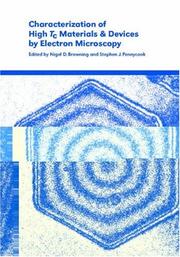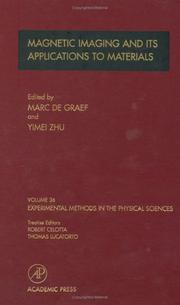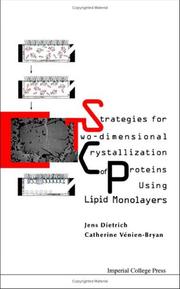| Listing 1 - 10 of 13 | << page >> |
Sort by
|
Book
Year: 2022 Publisher: London : IntechOpen,
Abstract | Keywords | Export | Availability | Bookmark
 Loading...
Loading...Choose an application
- Reference Manager
- EndNote
- RefWorks (Direct export to RefWorks)
This book provides an overview of the principles and types of electron microscopes. It also describes the different practical applications of electron microscopes, ranging from particle analysis and materials characterization to industrial failure analysis and process control. Over eight chapters divided into two sections, this book gives readers a comprehensive and updated review of the latest advances in electron microscopy.
Book
Abstract | Keywords | Export | Availability | Bookmark
 Loading...
Loading...Choose an application
- Reference Manager
- EndNote
- RefWorks (Direct export to RefWorks)
The book "The Transmission Electron Microscope" contains a collection of research articles submitted by engineers and scientists to present an overview of different aspects of TEM from the basic mechanisms and diagnosis to the latest advancements in the field. The book presents descriptions of electron microscopy, models for improved sample sizing and handling, new methods of image projection, and experimental methodologies for nanomaterials studies. The selection of chapters focuses on transmission electron microscopy used in material characterization, with special emphasis on both the theoretical and experimental aspect of modern electron microscopy techniques. I believe that a broad range of readers, such as students, scientists and engineers will benefit from this book.
Book
ISBN: 1283143550 9786613143556 9812836683 9789812836687 9789812836670 9812836675 9781283143554 6613143553 Year: 2011 Publisher: Singapore London World Scientific
Abstract | Keywords | Export | Availability | Bookmark
 Loading...
Loading...Choose an application
- Reference Manager
- EndNote
- RefWorks (Direct export to RefWorks)
This book contains proposals to redesign the scanning electron microscope, so that it is more compatible with other charged particle beam instrumentation and analytical techniques commonly used in surface science research. It emphasizes the concepts underlying spectrometer designs in the scanning electron microscope, and spectrometers are discussed under one common framework so that their relative strengths and weaknesses can be more readily appreciated. This is done, for the most part, through simulations and derivations carried out by the author himself. The book is aimed at scientists, engi
Book
ISBN: 1283433346 9786613433343 9814289558 9789814289559 9781283433341 9789814289542 981428954X Year: 2011 Publisher: Singapore Hackensack, NJ World Scientific Publishing Co.
Abstract | Keywords | Export | Availability | Bookmark
 Loading...
Loading...Choose an application
- Reference Manager
- EndNote
- RefWorks (Direct export to RefWorks)
The book presents a clear and comprehensive review of the current status of the holographic microscopy with discussion of the positive and negative features of classical and holographic methods for solving the problem of three-dimesional (3D) imaging of phase microscopic objects. Classical and holographic methods of phase, interference and polarization contrast are discussed. Combination of the developed holographic methods with the methods of digital image processing allowed creating the digital holographic interference microscope (DHIM). The first 3D images of native phase microscopic object
Electron microscopes. --- Microscopy. --- Microscopy --- Technique.

ISBN: 1107113016 1280417013 9786610417018 0511175078 0511039662 0511155174 0511328664 0511534825 0511053398 9780511039669 9780511534829 9780511038150 0511038151 6610417016 9780511053399 052155490X 9780521554909 9781107113015 9781280417016 9780511175077 9780511155178 9780511328664 9780521031707 0521031702 Year: 2000 Publisher: Cambridge New York Cambridge University Press
Abstract | Keywords | Export | Availability | Bookmark
 Loading...
Loading...Choose an application
- Reference Manager
- EndNote
- RefWorks (Direct export to RefWorks)
This is a clear account of the application of electron-based microscopies to the study of high-Tc superconductors. Written by leading experts, this compilation provides a comprehensive review of scanning electron microscopy, transmission electron microscopy and scanning transmission electron microscopy, together with details of each technique and its applications. Introductory chapters cover the basics of high-resolution transmission electron microscopy, including a chapter devoted to specimen preparation techniques, and microanalysis by scanning transmission electron microscopy. Ensuing chapters examine identification of superconducting compounds, imaging of superconducting properties by low-temperature scanning electron microscopy, imaging of vortices by electron holography and electronic structure determination by electron energy loss spectroscopy. The use of scanning tunnelling microscopy for exploring surface morphology, growth processes and the mapping of superconducting carrier distributions is discussed. Final chapters consider applications of electron microscopy to the analysis of grain boundaries, thin films and device structures. Detailed references are included.
High temperature superconductors. --- Electron microscopy --- Electron microscopes --- Materials at low temperatures --- Superconductors --- Technique. --- Technique

ISBN: 1280523247 9786610523245 0195364651 9780195364651 9781280523243 0195042751 9780195042757 661052324X Year: 1988 Publisher: New York Oxford University Press
Abstract | Keywords | Export | Availability | Bookmark
 Loading...
Loading...Choose an application
- Reference Manager
- EndNote
- RefWorks (Direct export to RefWorks)
Provides an introduction to the fundamental concepts, techniques, and methods used for electron microscopy at high resolution in space, energy, and even in time. This book includes discussions of the theory and practice of image calculations, and applications of HRTEM to the study of solid surfaces, highly disordered materials, and more.
Book
ISBN: 1316883531 1316883647 1316883752 1316337456 1316883868 1316884198 131688287X 9781316337455 9781316884195 9781316883860 9781107116573 1107116570 Year: 2017 Publisher: Cambridge Cambridge University Press
Abstract | Keywords | Export | Availability | Bookmark
 Loading...
Loading...Choose an application
- Reference Manager
- EndNote
- RefWorks (Direct export to RefWorks)
The first book on the topic, with each chapter written by pioneers in the field, this essential resource details the fundamental theory, applications, and future developments of liquid cell electron microscopy. This book describes the techniques that have been developed to image liquids in both transmission and scanning electron microscopes, including general strategies for examining liquids, closed and open cell electron microscopy, experimental design, resolution, and electron beam effects. A wealth of practical guidance is provided, and applications are described in areas such as electrochemistry, corrosion and batteries, nanocrystal growth, biomineralization, biomaterials and biological processes, beam-induced processing, and fluid physics. The book also looks ahead to the future development of the technique, discussing technical advances that will enable higher resolution, analytical microscopy, and even holography of liquid samples. This is essential reading for researchers and practitioners alike.
Electron microscopy --- Liquids --- Transmission electron microscopy. --- Technique. --- Microscopy. --- Fluids --- Permeability --- Polywater --- Electron microscopes --- Technique

ISBN: 9780124759831 0124759831 9780080531373 0080531377 1281033286 9781281033284 9786611033286 Year: 2001 Publisher: San Diego Academic Press
Abstract | Keywords | Export | Availability | Bookmark
 Loading...
Loading...Choose an application
- Reference Manager
- EndNote
- RefWorks (Direct export to RefWorks)
Volume 36 provides an extensive introduction to magnetic imaging,including theory and practice, utilizing a wide range of magnetic sensitive imaging methods. It also illustrates the applications of these modern experimental techniques together with imaging calculations to today's advanced magnetic materials. This book is geared towards the upper-level undergraduate students and entry-level graduate students majoring in physics or materials science who are interested in magnetic structure and magnetic imaging. Researchers involved in studying magnetic materials should alsofind th

ISBN: 1281866679 9786611866679 186094678X 9781860946783 9781860944284 1860944280 9781281866677 6611866671 Year: 2005 Publisher: London Imperial College Press
Abstract | Keywords | Export | Availability | Bookmark
 Loading...
Loading...Choose an application
- Reference Manager
- EndNote
- RefWorks (Direct export to RefWorks)
Strategies for Two-Dimensional Crystallization of Proteins UsingLipid Monolayers presents an overview of different methods thatlead to structure determination by electron microscopy. These methodshave proven to be extremely successful, especially for elucidating thestructure of membrane proteins.
Membrane proteins. --- Crystallization. --- Electron microscopy --- Electron microscopes --- Chemistry --- Chemistry, Physical and theoretical --- Separation (Technology) --- Membranes (Biology) --- Proteins --- Technique. --- Technique
Book
ISBN: 0128185732 9780128197035 012819703X 9780128185735 Year: 2020 Publisher: San Diego, CA, USA Elsevier Science
Abstract | Keywords | Export | Availability | Bookmark
 Loading...
Loading...Choose an application
- Reference Manager
- EndNote
- RefWorks (Direct export to RefWorks)
Ultrahigh vacuum. --- Vacuum technology. --- Electron microscopes. --- Electron microscope --- Microscopes --- Industrial vacuum --- Vacuum --- Vacuum in industry --- Ultrahigh vacuum --- Vacuum technology --- Industrial applications
| Listing 1 - 10 of 13 | << page >> |
Sort by
|

 Search
Search Feedback
Feedback About UniCat
About UniCat  Help
Help News
News